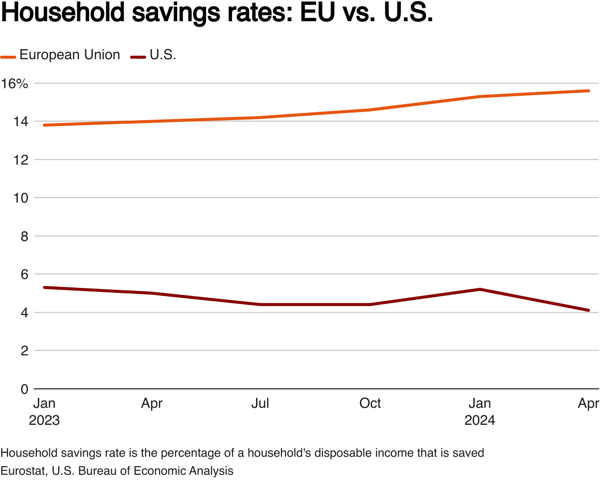Savings and Investment Union: How the EU is Targeting Citizens’ Savings
In March, the European Commission introduced a major new initiative, claiming it as game-changing for the bloc’s growth and global competitiveness. President Ursula von der Leyen unveiled the “Savings and Investment Union” (SIU), a plan that’s aimed at harnessing fresh capital—primarily from private sources—to fund strategic investments across Europe.
“Savings and Investment Union: How the EU is Targeting Citizens’ Savings” was taken from BFI Bullion’s recent quarterly newsletter, the Digger, published on July 14, 2025. To read this latest quarterly Digger in its entirety, click here.
The EU has been struggling for long time with inadequate public funding that fails to cover its chronically excess spending, as was highlighted in a report by Mario Draghi in September 2024. The bloc is estimated to need an annual investment of 750-800 billion euros by 2030 to modernize its economy, to pay for all its ambitious plans and initiatives, and to maintain its foundational socioeconomic model. The former chief of the European Central Bank warned that the current path the EU is on is one of “managed and gradual decline” that is “condemning itself to a slow agony”, and unless something changes, the Union is very likely to suffer long term economic stagnation, as well as serious challenges in terms of geopolitical relevance, security and independence.
Brussels has been growing increasingly concerned over this massive funding gap, especially since additional military spending has been added to the bill following the Russia-Ukraine war. Rather unsurprisingly, EU leaders only see one solution to this conundrum: raising more money from new sources (finding ways to simply spend less doesn’t even seem to be on the table). Given that income tax levels are already at record highs in many EU countries and that it would be politically untenable to force citizens to contribute even more, a certain amount of creativity was required on the part of policymakers. If they can’t extract more funds directly and openly through taxation, they need to tap into the leftover money that the citizens get to keep from their paychecks after taxes. In other words, they needed to get that extra funding from private savings, and that’s what the SIU is essentially designed to accomplish.
As economics professor and policy advisor Elisabeth Krecké wrote in an analysis for GIS in May: “Policymakers have long been interested in how much citizens save. However, they have often viewed average saving behaviors negatively. For years, they criticized Europeans for saving excessively, far more than, for instance, their American counterparts. Each year, European households save 1.4 trillion euros, nearly double the 800 billion euros saved in the United States. Of this amount, about 300 billion euros are invested in foreign markets outside Europe. In the decade following the 2008 financial crisis, policymakers and their economic advisors, mostly Keynesians, warned that such hoarding was detrimental. They claimed this “savings glut” starved the economy of much-needed resources…. In 2025, the policy narrative has shifted, and new ideas are on the table. Policymakers now recognize the immense potential of the 10 trillion euros sitting unused in low-yield savings accounts across Europe. What was once considered a liability is now seen as an invaluable treasure that is waiting to be tapped.”

But how exactly will those personal savings be accessed and put to work to close the bloc’s funding gap? Well, according to the SIU factsheet published by the European Commission, it would be done “by choosing to allocate a portion of their savings into productive investments to finance the EU’s objectives (e.g. climate transition, innovation or defense), citizens can enjoy higher returns and prepare for their future.” The leadership in Brussels aims to incentivize European savers to invest in ways that are “good for the Union” primarily though tax breaks, but they are also set to roll out a massive financial literacy program to “educate” them properly too.
It’s hard to see why anyone would trust unelected bureaucrats with providing investment advice, especially since it is clear from the start that the policymakers’ goals are not to maximize returns for investors, but to find a way to pay for their policies. It is equally hard to imagine that said policymakers are naive enough to expect that ordinary people would upend their entire retirement plans and financial planning strategies and follow their “advice”, with only tax breaks to entice them. It is far more likely that tax breaks, or the “carrot” of policy enforcement, will be accompanied by a “stick”, or a punishment for the failure to comply - perhaps increased taxes on savings sitting at the bank?
To any rational observer, especially those with some basic understanding of economics and investing principles, the SIU scheme looks like a disaster in the making. However, it is only the latest in a long line of misguided and ill thought-out policies by desperate governments resorting to desperate measures. This is why it is more important than ever to plan ahead and ensure at least some of one’s savings are as far as possible from the reach (and overreach) of the government. Physical precious metals, stored outside of your home country in a jurisdiction that can be counted on more than your own still remains the most reliable way to achieve that.
>>Read the entire Digger here.





